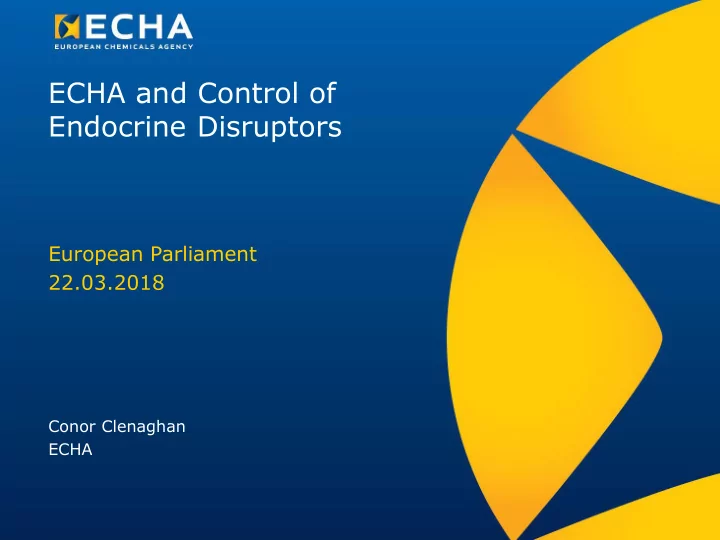

ECHA and Control of Endocrine Disruptors European Parliament 22.03.2018 Conor Clenaghan ECHA
ECHA overview
Chemicals legislations managed by ECHA REACH CLP BPR PIC Registration Classification Biocides Prior Informed Evaluation Labelling Consent Authorisation Packaging All chemicals All chemicals Active substances Import/export of >1 tonne and mixtures and biocidal certain hazardous per annum products chemicals UN-wide standards Rotterdam Convention Wealth of information unique in the world Companies are required to collect or generate information on properties and uses of their chemicals, assess the risks and recommend safety measures. All this information is submitted to ECHA Several new work areas, e.g. • Portal for notifications of hazardous mixtures to the national poison centres • EU Nano Observatory ∙ EU Chemicals Legislation Finder • Occupational Exposure Limits (OELs) ∙ POPs Regulation • Database to track chemicals (Waste Framework Directive) 3
REACH and CLP – main processes and actors Facilitated by ECHA, industry Registration gathers information and Self-classification ensures management of risks Evaluation ECHA and MSCAs control • Dossier evaluation and request further info • Substance evaluation Member States Authorisation Commission, with support of ECHA and MSCAs, applies Restriction community wide risk Harmonised C&L management measures 4
How are endocrine disrupting chemicals regulated?
REACH contribution to managing endocrine disrupters Registration and screening The registration data together with other available • information allows identification of potential EDs ECHA screens the data regularly and identifies candidates • for further work by MSCAs and itself; Focus on fully registered substances and structurally • similar substances 6
REACH contribution to managing endocrine disrupters Further information generation Further information on ED properties can be requested from • industry: 82 substances on ECHA’s Community Rolling Action Plan for evaluation due to potential ED properties Assessments are not straightforward: ED expert group • supports the Member States Information obliges industry to ensure safe use • 7
ED Assessment Discussions informed by e.g.: • Widely accepted ED definition (WHO/IPCS, 2002) "exogenous substances that alter function(s) of the endocrine system and consequently cause adverse health effects in an intact organism or its progeny, or ( sub)populations“ • Joint Research Centre ED Expert Advisory Group report and European Food Safety Authority (EFSA) opinion on identification of EDs • OECD conceptual framework for testing and assessment of EDs and guidance documents 8
REACH contribution to managing endocrine Regulatory risk management under disrupters REACH Aim: promote substitution and ensure high • level of protection until the move to alternatives takes place 12 substances included in the Candidate List • due to ED properties - mainly phthalates and phenols including BPA Substances with ED properties are already • subject to authorisation requirement and restrictions REACH data and identification of the ED • properties can be used as a basis to take action under other legislation Several EU legislation refer to and require • action based on the ED properties 9
Biocidal Product (and Plant Protection Product) Regulations • ED criteria for biocidal products in force and currently under scrutiny for plant protection products • ED criteria for biocides and PPP are based on the WHO definition • ECHA is developing together with EFSA and JRC guidance for hazard based identification of EDs • MSCAs and stakeholders have been consulted during the drafting, public consultation • Current timetable: publication June 2018 10
Concluding remarks • REACH provides • Information and tools for the identification of EDs – but potential room for improvement in data quality / quantity and speed of identification process • Obligations on industry to ensure safe use, support for substitution • Possibilities for authorities to introduce regulatory risk management • Under REACH, ECHA has identified, and imposed more severe controls on, ED substances 11
Thank you! Subscribe to our news at: echa.europa.eu/subscribe Follow us on: • Twitter • YouTube • Facebook • LinkedIn • Wikipedia
Recommend
More recommend